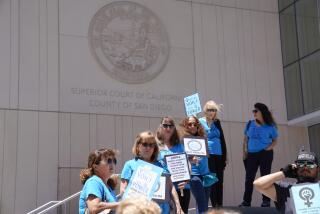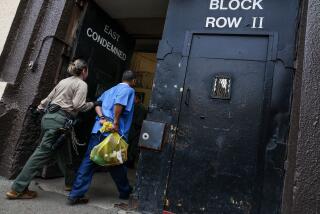Some inmates are set free early
- Share via
SACRAMENTO — California prison officials, facing severe overcrowding and a financial crisis, have been granting early releases to inmates serving time for parole violations.
State officials said the dozens of prisoners set free from the California Institution for Men in Chino and from lockups in San Diego and Shasta counties had 60 days or less left on their terms, or had been accused of violations and were awaiting hearings. The releases were approved by the state parole board.
At least 89 inmates have been freed or approved for early release during the last two months. Others have been sent to home detention, drug rehabilitation programs or similar alternative punishments.
They were screened to ensure that they had never been convicted of the most serious crimes, such as murder, manslaughter, kidnapping or sexual offenses, the officials said. The inmates may have been convicted of grand theft, weapons possession, driving under the influence of alcohol or other crimes. Their parole may have been revoked for missing an appointment with a parole agent, failing a drug test, committing robbery or other offenses.
The move came as authorities in Los Angeles County and elsewhere said they could no longer house -- and in some cases, threatened to release -- inmates awaiting transfer to state prisons from their own teeming jails. Counties routinely hold newly convicted prisoners or those picked up on parole violations until the state can take them.
But California’s $26.3-billion deficit has left the state without enough money to pay for all of those its laws designate for punishment. Gov. Arnold Schwarzenegger and lawmakers are considering numerous ways, including the early release of inmates, to save money by reducing a prison population of nearly 170,000.
No budget decisions have been made, and Schwarzenegger spokesman Matt David said the governor had been unaware of the recent releases, most of which were in response to complaints by L.A. County that the state had left nearly 2,000 prisoners in its jails. That number represents about 10% of the prisoners in the county’s jail system, which has a court-ordered population cap.
“This was an emergent crisis,” said Terri McDonald, the chief deputy secretary for adult operations at the Department of Corrections and Rehabilitation. “We don’t want a system failure in the county jail.”
The inmates released from Chino opened up beds for some of those being held in L.A. County. McDonald said the state, to be “good partners” with the county, put other inmates in prison gyms that officials had planned to stop using as dorms, and took additional measures to free up space.
Los Angeles County Sheriff Lee Baca, however, said that the burden had not been alleviated and that the inmates, who cost the county $70 million a year to house, were the state’s responsibility.
“If they’re releasing them . . . that’s their call,” Baca said. “For them to blame me for their decision is absurd. All I’m saying is, ‘I don’t want them in my jail any longer. You’re not paying me, and we’re not offering a free ride.’ ”
In a June 30 e-mail, a state parole administrator told agents that the Chino prison would be the “first target” for releasing parole violators. Because of the fiscal crisis, the e-mail said, “we are starting to experience some resistance and refusals of the counties to hold our prisoners” and the state was “incapable” of taking them.
Shasta County, for instance, had recently been forced to close a jail wing because sheriff’s deputies were laid off, wrote the administrator, whose e-mail was provided to The Times without a name attached.
The county had notified the state the week before that unless “30 or so” inmates were transferred, it would “release them to the streets over the weekend,” the e-mail said.
Five were evaluated and released early, with approval from the parole board; the rest were transferred to state prisons, corrections officials said.
In San Diego, 200 inmates are transferred from local jails to state prisons each week. After the state abruptly stopped accepting them in May, then-Sheriff William Kolender warned prison officials that he would release 138 parole violators to avoid exceeding his jails’ court-ordered population cap.
“We regret to take this drastic action, but we have no other alternative given our responsibility to adhere to a court order,” Kolender wrote in a letter dated May 5. He added that the county had been “burdened with holding state prisoners for an inordinate amount of time and cost.”
The county did not carry out its threat because the state approved two inmates for early release, sent some home on alternative sanctions and transferred others to state prisons.
--
Times staff writer Patrick McGreevy contributed to this report.
More to Read
Sign up for Essential California
The most important California stories and recommendations in your inbox every morning.
You may occasionally receive promotional content from the Los Angeles Times.










